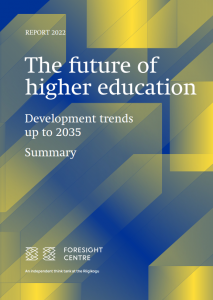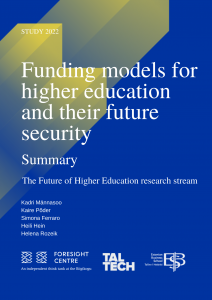The Future of Higher Education

Higher education is on the threshold of dramatic changes. The labour market is in a whirr of transformation brought on by technological development, but also demographic and social shifts. It is no longer appropriate to condense the learning activities into the first phase of the life cycle; instead, periods of study alternate with periods of work.
The newly coined term just-in-time learning reflects the importance of being able to learn specific skills whenever the need for these arises. Micro and nano degrees as well as all the other “bite-sized learning” options are revolutionising higher education, and the percentage of mature students is on the rise. This also has consequences for the education financing system – how can we ensure that people have the possibility to occasionally step out of their work life in order to advance their knowledge and skills? Several countries are discussing the so-called life accounts, which would be funded by a percentage of the individual’s taxes and could be used to cover education expenses.
Traditionally, higher education has been divided into disciplines, while the labour market increasingly calls for the linking of the disciplines and developing strong general skills. The traditional degree programmes provide a wide range of knowledge and skills connected to the chosen profession, which the student might need one day, but just as well might not. The employers are becoming disillusioned in degree programmes, which makes these an increasingly less attractive use of time from the students’ point of view.
How can the traditional degree programmes keep their value and significance in this situation, if at all? Could higher education be split into its constituent parts, only to be put back together into individual wholes, tailored to the intentions and abilities of each student? To use a music industry analogy – the time is long past when we needed to buy the whole album to listen to one piece of music; instead, it can be easily combined on a streaming platform (e.g Spotify) with music from other artists. What would such developments in higher education mean for the school, the student, or the higher education financing?
Here and there around the world, we have seen emerge higher education providers who link payment for education with the later success of the student on the labour market. The student pays their school after having found a sufficiently well-paid job. If they cannot find a sufficiently well-paid job, they are not obliged to pay back. Platform type business models along with free access to online courses (MOOC) are reaching higher education as well. If universities become platforms, this could in the future mean that, for example, private market participants teach under the brand of a university, offering education that conforms to the quality standards of the university. In that case, the core service provided by the university would be setting the quality threshold and assessing the conformity with this, and no longer providing the education.
Key research questions
- Which changes are on the horizon for higher education around the world and in Estonia? What would these development mean for the economy, the higher education institutions, and the individuals?
- How should the financing principles of higher education change, considering the different possible development trends of higher education?
Reports linked to the research
News linked to the research
-
09.06 2022Report: Higher education institutions will need to adapt faster to market demands
In order to remain competitive, higher education institutions will need to adapt faster to the needs of the education market, says the Foresight Centre Report “The Future of Higher Education. Development Trends until 2035”, published yesterday. In the next decade, the need for continuing education will increase significantly, which will require greater flexibility from higher education institutions and the state in regard to forms of study.

 An independent think tank at the Riigikogu
An independent think tank at the Riigikogu 



